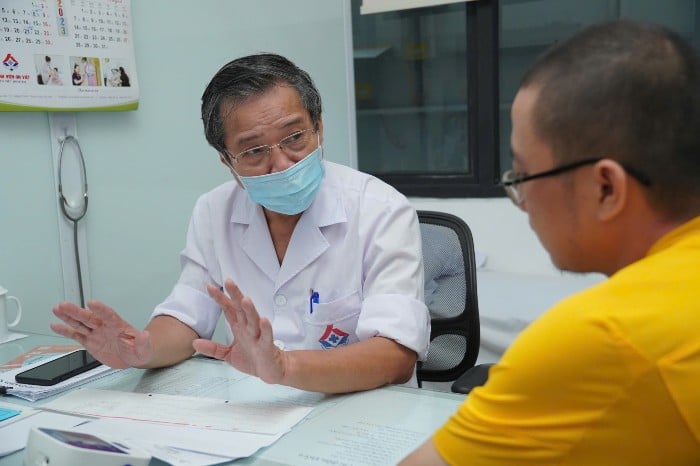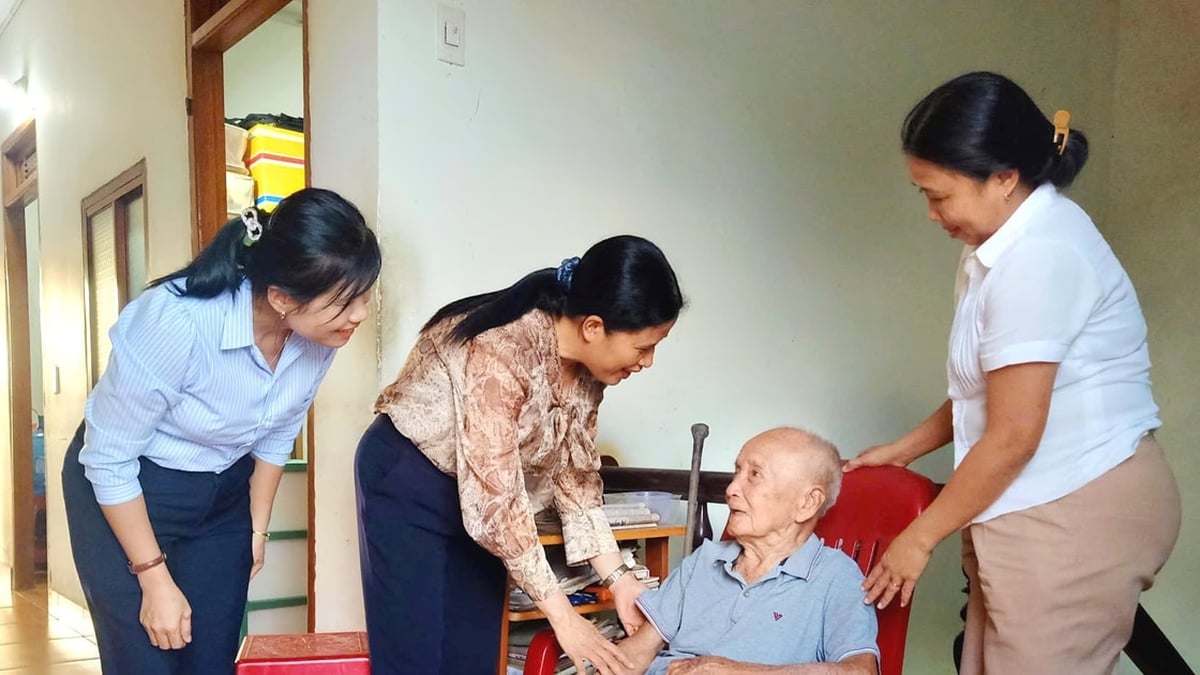To date, the number of people participating in health insurance has increased 13.4 times compared to 1995, corresponding to more than 94.2% of the population.
Medical news on February 11: Every year there are nearly 200 million medical examinations and treatments covered by health insurance
To date, the number of people participating in health insurance has increased 13.4 times compared to 1995, corresponding to more than 94.2% of the population.
Nearly 200 million health insurance visits each year
The rate and number of people participating in health insurance have increased rapidly, approaching the goal of universal health insurance. To date, the number of people participating in health insurance has increased 13.4 times compared to 1995, equivalent to more than 94.2% of the population. Each year, the Vietnam Social Insurance sector handles nearly 200 million health insurance examinations and treatments.
 |
| Every year, the Vietnam Social Insurance sector handles nearly 200 million health insurance medical examinations and treatments. |
According to statistics, the rate of participation in Social Insurance and Health Insurance has increased rapidly over the years. The number of people participating in Social Insurance has increased 8.9 times compared to 1995, reaching 42.71% of the working-age workforce. In particular, voluntary Social Insurance has attracted about 2.311 million people, exceeding the target of Resolution 28 of the Party.
The health insurance coverage rate has reached over 94% of the population, an impressive figure, contributing significantly to the protection and care of people's health. Each year, the Social Insurance sector handles more than 3.3 million pensioners and social insurance benefits, and nearly 200 million health insurance examinations and treatments.
The Social Insurance sector has also promoted administrative procedure reform and information technology application. In 2024, Vietnam Social Insurance will be one of 7 agencies to complete 100% of the administrative procedure simplification plan, ranking 3rd among ministries and sectors in terms of service index for people and businesses.
These achievements are a testament to the tireless dedication of generations of cadres, civil servants and public employees in the Vietnam Social Insurance sector. The sector not only creates practical values but also plays an important role in ensuring social security, improving people's quality of life and promoting sustainable development.
The achievements over the past 30 years are a strong driving force for the Social Insurance sector to continue to innovate, create and improve operational efficiency, towards the goal of building a strong, comprehensive and humane social security system.
A cluster of measles cases appeared with 16 cases in Quang Ninh
According to authorities, a cluster of measles cases has been recorded in a fishing village resettlement area (Ha Phong ward, Ha Long city, Quang Ninh) with 16 cases.
According to information from the Quang Ninh Center for Disease Control (CDC), since the beginning of 2025, the unit has monitored 50 cases of rash fever suspected of measles, of which 32 cases tested positive for measles virus. In Ha Long City alone, as of the end of February 7, a cluster of cases was recorded in the fishing village resettlement area (zone 8, Ha Phong ward) with 16 cases positive for measles virus.
Faced with this situation, the Quang Ninh CDC has directed and instructed the Ha Long City Medical Center and the Ha Phong Ward Medical Station to immediately implement measures to prevent and control measles. Specifically, the Ha Phong Ward Medical Station has reviewed and compiled a list of children from 9 months to under 16 years old who are eligible to live in Zone 8 to receive vaccinations.
Currently, measles has no specific treatment and is easily spread through the respiratory tract, through droplets from infected people or direct contact with the patient's secretions, especially in crowded places such as schools and public places.
Therefore, parents need to pay attention to taking their children to get enough doses of vaccine on schedule to help create immunity to prevent disease, limit the risk of measles and prevent serious disease progression.
Hepatitis B patients arbitrarily stop taking medication, acute liver failure and hepatic coma
Recently, the Hepatitis Department, Central Hospital for Tropical Diseases received patient LVT, 51 years old, from Kien An, Hai Phong , in a state of severe jaundice and acute liver failure. The main cause was that the patient had stopped taking medication for hepatitis B on his own.
Two years ago, patient LVT was diagnosed with chronic hepatitis B and prescribed antiviral drugs to control the disease. However, the patient did not comply with the treatment, did not take the medication regularly, and especially stopped taking the medication on his own more than a month before being admitted to the hospital.
After about 2 weeks of stopping the medication, the patient began to feel tired, had a poor appetite, felt full, and was afraid of fat, but did not go to the doctor. By the third week, the patient had obvious jaundice, dark urine, pale stools, and a distended abdomen due to ascites. By the fourth week, the patient had generalized edema, subcutaneous hemorrhage, decreased consciousness, and poor response.
The family brought the patient to the medical facility in a state of severe jaundice, large ascites, slow communication and signs of progressive liver failure. Although the patient had undergone dialysis and plasmapheresis twice at the previous medical facility, the condition did not improve. The patient was then transferred to the Hepatitis Department, Central Hospital for Tropical Diseases for further treatment.
At the hospital, the patient was diagnosed with acute liver failure, cirrhosis, chronic hepatitis B, grade 2 hepatic coma and was at risk of rapidly progressing to grade 3-4 if not controlled promptly.
The patient's bilirubin index at the time of admission was more than 400 µmol/L (normal is below 17 µmol/L), despite 2 plasmapheresis.
The patient's prothrombin index was only below 30% (normally above 70%), causing blood clotting disorders and severe subcutaneous bleeding. The patient also showed signs of kidney failure due to hepatorenal syndrome, with a creatinine index increasing more than 50% compared to normal and a sharp decrease in urine output.
According to Dr. Doi Ngoc Anh, Department of Hepatitis, Central Hospital for Tropical Diseases, when patients with chronic hepatitis B arbitrarily stop taking medication, the virus can reactivate strongly, causing acute hepatitis and serious liver damage.
Initially, the patient may only feel tired, have poor appetite, have abdominal fullness and jaundice that is not obvious. However, after 2-3 weeks, jaundice and yellow eyes will begin to appear, urine will be dark, and the abdomen will be distended due to accumulation of abdominal fluid. As the disease gets worse, the patient may have generalized edema, subcutaneous hemorrhage and signs of hepatic coma (hepatic encephalopathy), loss of concentration and confusion.
Doctor Ngoc Anh said that hepatic coma (hepatic encephalopathy) is a dangerous complication of acute liver failure. When the liver is no longer able to remove toxins, the toxins accumulate in the blood, causing neurological disorders.
This disease has 4 levels, from mild confusion to deep coma. If not controlled promptly, the patient may fall into grade 4 hepatic coma, multiple organ failure and death. In this case, if not responding to medical treatment, the patient may need a liver transplant to sustain life.
Hepatitis B is the leading cause of cirrhosis and liver cancer. Many patients think that by taking antiviral drugs they are not at risk of liver cancer, but in fact, even with treatment, this risk still exists.
Most importantly, patients need to have regular check-ups every 3-6 months to control the disease and screen for liver cancer with ultrasound and specialized tests. In particular, when stopping the drug, the virus can flare up quickly, accelerating the progression of cirrhosis and liver cancer.
Doctor Ngoc Anh emphasized that regular check-ups help detect liver cancer early. If the tumor is detected in the early stages, treatment will be much more effective than when the disease has progressed severely.
Therefore, each patient with hepatitis B needs to be aware of protecting their health, comply with the treatment regimen and proactively monitor their health periodically, not arbitrarily stop taking medication to avoid dangerous complications and improve quality of life.
Source: https://baodautu.vn/tin-moi-y-te-ngay-112-moi-nam-co-gan-200-trieu-luot-kham-chua-benh-bao-hiem-y-te-d245329.html























![[Photo] Gia Lai provincial leaders offer flowers at Uncle Ho's Monument with the ethnic groups of the Central Highlands](https://vphoto.vietnam.vn/thumb/1200x675/vietnam/resource/IMAGE/2025/7/9/196438801da24b3cb6158d0501984818)
















































































Comment (0)